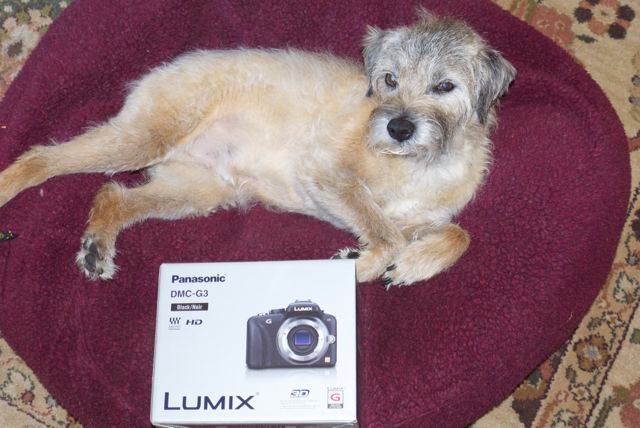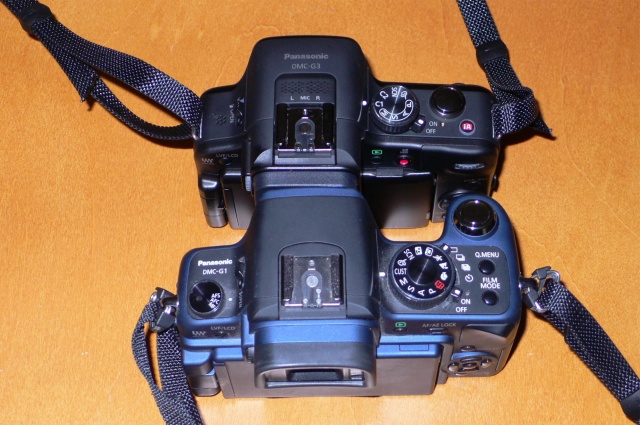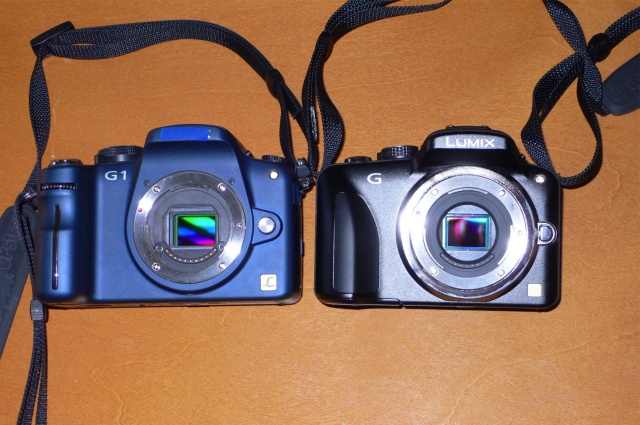Finally here!

Under attack dog guard. Bert keeps an eye on the G3.
The Panasonic G1 was a truly revolutionary camera. It was the first to incorporate a proper, usable electronic finder and interchangeable MFT lenses. The design is now reaching a broad audience and will do great harm to slow moving Canon and Nikon who have either awful alternatives (like Nikon’s V1) or none (Canon). Click in the right hand column under Categories->Photography to access my earlier articles on this ground breaking design. I passed on the G2 which added a movie mode and a touch screen but used the G1’s sensor. There was no compelling reason to upgrade for my purposes.
While the wait for my Panasonic G1 has been just short of six months, it would be churlish to complain. Japan has been ravaged by an earthquake, tsunami and radiation in that time and is digging its way out without a single case of looting or crime. Imagine saying that of any other nation on earth. So, thanks, Panny, for getting things together and back into production. Though the G3 says ‘Made in China’, unlike the Japanese G1, many of the components originate in Japan, so the delay is understandable.
If I say that 14,000+ pictures later that the G1 is second nature to me, that’s not quite true. No modern camera with the myriad of adjustable variables can ever be second nature, not when there are literally millions of combinations permitted. But once you have it set just so, it does become an old friend; I find that once set, I never change my preferred settings. Thus I went about cloning these settings to the G3 as soon as it arrived. The battery is half charged, so I simply charged the spare while doing this. It took almost two hours to get it right, not helped by the fact that there are many more menu choices in the G3 – movie modes and touch screen options being the dominant causes of bloat.
I will not be saying much about the touch screen, as I have no use for LCD screens in cameras. It’s actually ‘push’ rather than ‘touch’- it’s pressure sensitive, unlike the superior capacitive one on an iPhone or iPad. I shoot from the eye, using the Electronic ViewFinder (EVF). The day I compose snaps holding a camera at arm’s length and squinting at a poky screen will be a cold one in hell.
Immediate reactions? The body really cannot get much smaller. For my largish hands it’s at the limit of smallness to be easily worked and some controls, like the countersunk Display button on the back panel, are tough to use. Mercifully, that one is rarely, if ever, used after the initial setting. The smaller front handgrip is as comfortable as the G1’s larger one, and the rotating adjuster wheel is now in the rear (like on the G2) but has been stiffened to prevent accidental depression – an action which permits aperture or shutter speed change in the respective modes. I still struggle with the front mounted wheel on the G1, occasionally depressing it by accident. So while the G3 wheel is a tad rough to the feel, the trade off is worth it.

The G1 and G3. Only a twit uses the stock strap. Those are Upstraps.
Note the much improved, ringless strap attachment points – silent for movie makers.
The AE lock button has disappeared but the Fn2 button is easily assigned that task, allowing locking of exposure when recomposing.
Shutter noise is the same as on the G3. Quiet and low frequency, so you will not draw undue attention to yourself in other than silent settings. I never use multiple shot mode so cannot comment. Decisive moments are not caught with machine guns.
The proximity sensor for the EVF has gone. If you use the LCD then a mechanical switch to the left of the EVF has to be pressed to alternate between LCD and EVF. I never use the LCD so it’s a non-issue. If you open the LCD it comes on. Close it and it reverts control to the EVF. But if you keep the LCD open, then the switch has to be worked. In the G1/G2, the proximity sensor did this for you. A cost cutting exercise in the G3, then, but not one which intrudes for this user.
One immediate improvement is the provision of two custom settings on the top dial – C1 and C2. This is wonderful for me, as I take most of my snaps at ISO320, but like to switch to ISO1600 for poor light. In the G1 that means fiddling about with EVF displays (or the LCD which is hard to read in bright light). Here, once programmed, it’s simply a case of turning the dial one notch – I have C1 at ISO320, C2 at 1600. All the Scene settings on the G1/G2 have been consolidated into one click on the dial and are invoked using display controls. A camera of this calibre does not need easily accessed Scene modes, so it doesn’t matter if these are deleted from the mode dial.

Note the escutcheon surrounding the G3’s lens mount – likely required to pad out the very thin body.
Sadly the G3 does not come in Blue or British Racing Green, so Black it is.
On an 8gB SDHC card (the G3 will also take high capacity SDXC cards, for long movies I suppose) the G1’s 611 RAW capacity falls to 459, exactly in line with the G3’s larger 16mp file size compared with the G1’s 12mp. The G2H is the only other Panny to include this higher pixel count sensor at this time, the GH2 adding sophisticated movie modes and the ability to use high quality external microphones; the G1 makes do with two small built-in mics.
The overall feel of the camera confers slightly greater confidence than the G1; while the weights are similar (G3 – 11.8 ozs, G1 – 13.4 ozs), the G3 packs more into a smaller volume, thus seeming more solid. I’m sure it’s just a psychological effect, for it’s not like my G1 had any reliability issues.
Strangely, the provided G3 body cap does not lock on the G1, but all three MFT lenses I own – the Oly 9-18, the 14-45 and 45-200 Panasonics – couple properly. If you want to switch off anti-shake in the latter two (the Oly has none) you can use the switch on the lens. Users of later lenses like the 14-42 kit lens will have to dive into the menu system. A step back, but a non-issue as I’m sticking with the outstanding 14-45 kit lens. The new, not yet available, Panny 14-42 OIS PZ kit lens with electronic zoom is much smaller than the 14-42/45 variants with their manual zoom control. The PZ optic claims higher performance than the already excellent manual zoom kit lenses, so it’s an intriguing prospect. I’ll take a look at the new $400 PZ 14-42 when it comes out to see if Panny’s design genius makes it workable for still photographers, the appeal being that it is very small, a size in keeping with the whole ‘small and light’ Micro Four-Thirds design ethos. It will quite possibly make the G3 a pocketable outfit – a true dream harkening back to the compact screw mount Leicas of yesteryear. I have fond memories of using Leica IIIA, IIIC and IIIG models many years ago with the collapsible 50mm Elmar. Tweed jacket-pocket specials.
One area where it’s hard to imagine any improvement is in manual focusing. In the G1, with focus set to auto, turning the manual focus ring would enlarge the image in the EVF for truly critical focus, as long as you kept up a first pressure on the shutter release. However, you lost any sense of composition in the G1, as you were looking at a hugely magnified part of the center of the image. The G3 nails it. Now a central rectangle opens in the EVF for critical focusing, yet the rest of the image appears in regular size around it. It’s as if someone had taken the center RF rectangle on a Leica M body and vastly magnified its content wthout changing the periphery, allowing composition to continue. Magic!
Over the weekend I’ll be wringing out the G3 on the streets and will comment on sensor quality when I have some images to work with. Needless to add I will have the sensor set to a 3:2 aspect ratio; 30+ years with Leicas have me composing in that format and I’m not about to change. 4:3, for me, is too square. I’ll be using SilkyPix to convert the RAW files to TIFF before import to Lightroom 3. A pain, but once Adobe adds the G3 to its PS/LR RAW engines, that nonsense will cease. Hopefully something good will present itself, allowing creation of 18″ x 24″ prints on the HP DesignJet wide carriage dye printer. That is the touchstone of quality chez Pindelski.
Part V is here.